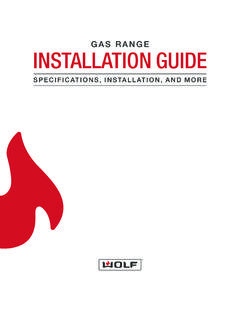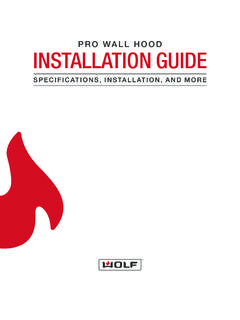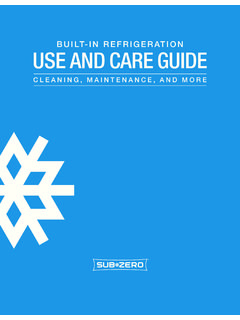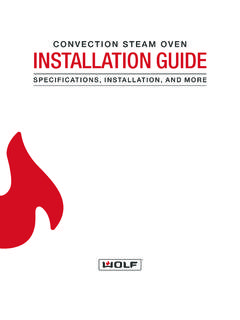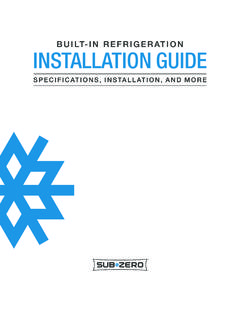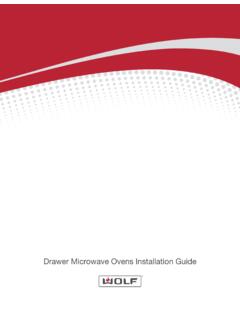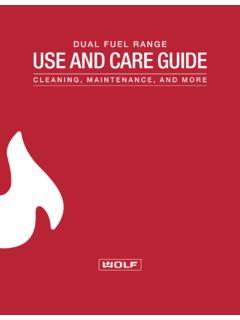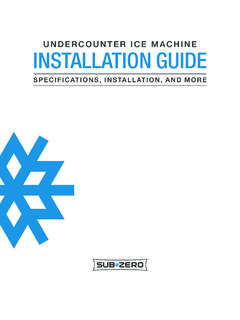Transcription of WOLF VENTILATION GUIDE - subzero-wolf.com
1 W O L F V E N T I L AT I O N G U I D E. REVISED 2 / 2018. TA B L E O F C O N T E N T S. 3 S E L E C T I N G A V E N T I L AT I O N S Y S T E M. 8 DETERMINE THE DUCT RUN. 10 DETERMINE THE CFM. 11 SELECT A BLOWER. 14 WOLF WARRANTIES. Features and specifications are subject to change at any time without notice. Visit for the most up-to-date information. Throughout this GUIDE , dimensions may vary by 1/8" (3). Dimensions in parentheses are millimeters unless otherwise specified. S E LECT ING A VENTIL ATION SYSTE M. Selecting a VENTILATION System When selecting a VENTILATION system, start by choosing the IMPORTANT NOTE: Wolf cooking products do not require proper Wolf VENTILATION product, determined by the type of VENTILATION when installed according to the installation cooking appliance used and the following considerations: instructions. Recommendations and suggestions in this GUIDE are for performance only. Cooktop or pro VENTILATION Updraft or downdraft Width guidelines Hood mounting height Ceiling height Cooking space / cooking style VENTILATION performance Internal, in-line, or remote blower Ducting considerations Electrical requirements Recirculating VENTILATION Custom hood applications | 3.
2 S E LECT ING A VENTIL ATION SYSTE M. Selecting a VENTILATION System C OO KT O P O R P RO VE NTIL ATION Wolf pro VENTILATION hoods and liners can be used with all cooking appliances, including ranges and rangetops. One of the primary considerations in choosing a VENTILATION A downdraft system can also be used with sealed burner product is the type of cooking appliance used. Wolf offers rangetop models SRT304 and SRT366. An accessory trim both cooktop VENTILATION , which includes hoods and down- kit is required for this installation and is avail able through an draft systems, and pro VENTILATION hoods and liners. authorized Wolf dealer. For local dealer information, visit the Wolf cooktop VENTILATION hoods and downdrafts are find a showroom section of our website, designed for use with induction, electric, and gas cooktops and modules. Some exceptions apply for downdrafts. The chart below provides a reference of Wolf VENTILATION products recommended for use with specific Wolf cooking appliances.
3 WOLF VENTILATION COOKTOP VENTILATION PRO VENTILATION . CO O K TOP D OWN D RAFT WAL L WA L L C H IM ISL A N D H OOD. HO O D SYSTEM H OOD H OOD H OOD LIN E R. CO O K T O P S. Induction Cooktop (transitional) . Induction Cooktop (contemporary) . Electric Cooktop (transitional) . Electric Cooktop (contemporary) . Gas Cooktop (transitional / professional) . Gas Cooktop (contemporary) . MODULES. Induction / Electric / Teppanyaki Module . Grill / Steamer / Fryer Module . Gas / Multifunction Module . RANGES. Dual Fuel Range . Gas Range . Induction Range . RANGETOPS. Sealed Burner Rangetop (SRT304, SRT366) . Sealed Burner Rangetop (all other models) . 4 | Wolf Customer Care S E LECT ING A VENTIL ATION SYSTE M. Selecting a VENTILATION System U P DR AF T O R DOWNDRAFT C EI LI N G H EI GH T. The choice between updraft VENTILATION and downdraft Before selecting a Wolf VENTILATION hood, check the installa- VENTILATION will depend on several factors, most notably the tion site for adequate ceiling height, or any extra space that cooking appliance, type of installation, and location.
4 Updraft may remain after proper installation of the hood and cooking VENTILATION , or an overhead hood, is typically a more effec- appliance. This can be determined by adding the floor-to- tive VENTILATION option. Cooking vapors naturally rise, making countertop height, plus the recommended hood mounting it easier to collect and remove them from the cooking area. height (bottom of the hood to the countertop), plus the height of the hood. With downdraft systems, a telescopic downdraft chimney rises up from the countertop and draws cooking vapors Excess ceiling height can be filled using an accessory flue away from the cooking surface. Downdraft VENTILATION is a extension or a stainless steel duct cover for pro hoods. The great option in installations where an overhead hood is not space can also be adjusted by raising or lowering the hood desired or is not a viable option. within the specified mounting height. W IDT H G UIDELI NE S C O O K I N G S PA C E | C O O K I N G S TY LE.
5 For wall installations, the width of the hood should be at The appropriate airflow capacity is determined by the least as wide as the cooking surface. Where space is not cooking space and cooking style. If the cooking surface restricted, a wider hood can be used to increase the capture is in an island or peninsula, a higher airflow capacity hood area. can provide better capture for cross currents, or if the hood needs to be mounted higher. Downdraft VENTILATION may also Island and peninsula installations require a greater capture be an option. area. Island hoods should exceed the width of the cooking surface by a minimum of 3" (76) on each side. Greater exhaust capacity is required to handle the moisture generated by boiling large pots of water or the grease and For downdraft VENTILATION systems, the width of the down- smoke from grilling or frying. Cooking with high heat or draft should match the width of the cooktop.
6 Cooking aromatic foods may require additional CFM and increasing the capture area by using a hood that exceeds H OO D MO UNT ING HE IGHT the cooking surface by 3" (76) on each side. Proper mounting height is very important. If a VENTILATION hood is mounted too low, access to the cooking surface V EN TI LATI O N PER FO R M A N C E. may be restricted. If a hood is mounted too high, perfor- VENTILATION performance is measured in cubic feet per mance may be compromised. minute, or CFM. The higher the CFM, the greater the For optimal performance, hoods should be mounted amount of air that is evacuated through the VENTILATION 30" (762) to 36" (914) from the bottom of the hood to the system. CFM suggestions are based on the cooking appli- counterop. Ceiling-mounted hoods should be mounted ance output. 36" (914) to 84" (2114) from the bottom of the hood to the countertop. | 5. S E LECT ING A VENTIL ATION SYSTE M. Selecting a VENTILATION System I N T ER NAL, IN-LINE , OR RE MOTE BL OWE R D U C TI N G C O N S I D ER ATI O N S.
7 All Wolf VENTILATION products are shipped without the blower IMPORTANT NOTE: Unless used in a recirculating applica- assembly. An internal, in-line, or remote blower must be tion, Wolf VENTILATION hoods and downdrafts must be vented selected to accommodate the cooking appliance and venti- to the outside. Use only rigid metal ducting. lation product. Typically, wall-mounted VENTILATION hoods can be vertical The blower will vary in size (CFM), which is dictated by the or horizontal discharge, while wall chimney hoods, island cooking surface, the volume of air that needs to be moved hoods and hood liners are vertical discharge only. For and the length of the duct run. some wall hoods, an accessory horizontal discharge kit is required. In a horizontal discharge application, additional Internal blowers are mounted inside the hood canopy or framework may be needed to accommodate the remote blower box and provide the least disruption to the exterior blower.
8 Wolf downdraft systems have an adjustable dis- of the home. charge that will allow you to negotiate ducting around floor In-line blowers are connected to the duct run between the joists and other obstacles. hood and the exterior of the home. This is a great option if Depending on the specific installation, ducting can run mounting the blower inside the hood or on the exterior of through the roof, external wall, or eave. A remote blower can the home is not desired or is not a viable option. not be ducted through an eave. Remote blowers can be mounted on the roof or, in some A straight, short duct run with a limited number of elbows cases, on an exterior wall. A remote-mounted blower will and transitions will allow the hood or downdraft to perform minimize the amount of blower noise but will not eliminate most efficiently. Wolf VENTILATION hoods will operate most the noise completely. If noise is a concern, a remote blower efficiently when the duct run does not exceed 50' (15 m).
9 Is recommended. in length, 40' (12 m) for downdrafts. To calculate total duct Internal, in-line and remote blowers are available for all Wolf length, refer to page 8. cooktop and pro VENTILATION products except under-cabinet hood inserts which only offer an internal blower option. ELEC TR I C AL R EQ U I R EMEN TS. All Wolf VENTILATION products require a separate grounded electrical supply. Installation must comply with all applicable electrical codes. A ground fault circuit interrupter (GFCI) is not recommended and may cause interruption of operation. 6 | Wolf Customer Care S E LECT ING A VENTIL ATION SYSTE M. Selecting a VENTILATION System VENTILATION Made Easy R ECIR CULAT ING VE NTIL ATION After choosing the proper VENTILATION hood or downdraft, follow this three-step process to determine your blower Recirculating units recycle the air through a charcoal filter needs to complete the VENTILATION system: and return it to the kitchen.
10 This type of VENTILATION will not remove heat, moisture, or combustion gases from the air. Step 1: Determine the Duct Run It will also be less effective in reducing odors and smoke. Recirculating units should only be used in applications Step 2: Determine the CFM. where ducting to the outside is not an option, and only if Step 3: Select a Blower local codes allow it. Wolf recirculating units are for use with cooktop hoods with an internal blower and some pro wall hood models. Recir- culating units should not be used with ranges or rangetops that contain a charbroiler or griddle. C U S T O M HO O D APPL ICATIONS. A custom decorative hood, used with pro hood liners, can be created out of wood, plaster, tile, or metal to match virtu- ally any design theme. The shape of the decorative hood is not critical as long as the hood liner fits completely inside the hood. The decorative hood and liner must fit together at the bottom edge in both width and depth.


